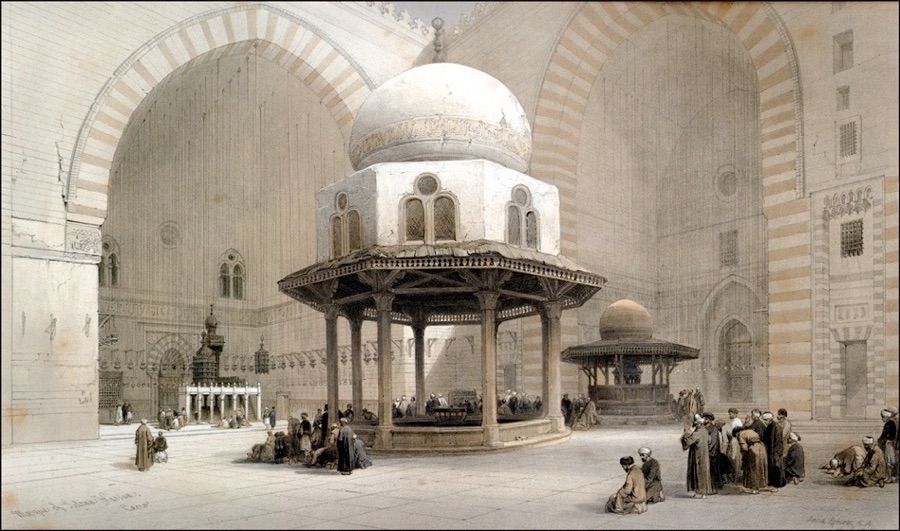INTERIOR OF THE MOSQUE OF THE SULTAN HASSAN
IT is only within a few years that a Frank, or Christian, has been permitted to enter a mosque, and there are many in Cairo from which they are still rigidly excluded, but in that of Sultan Hassan, which is the most sought to be visited by strangers, it is, under certain restrictions, allowed. The Christian must assume the Mohammedan costume, and be accompanied by a Cavass, or Janissary, and before ascending the great stair leading to the porch, his boots or shoes must be left in charge of his servant; for in the East it is still the custom, as in the days of Moses, to uncover the feet, as we uncover the head, in an act of reverence: Moses was commanded to put off his shoes, "for the place whereon he stood was holy ground."
On passing through the great porch of the Mosque of the Sultan Hassan, the visitors enter a magnificent court, about two hundred and fifty feet square. On each side is a deep arched recess; in that which is in front is the niche of the Mechráb, corresponding nearly to our chancel. Towards the Mechráb, which is placed, like our altar, on the east, all turn to pray; the recesses on the sides answer to the transepts of our sacred structures. From the arched roofs within these recesses, lamps are suspended by innumerable lines, in which, during the festivals, particularly that of Ramadan, lights are kept constantly burning; some of those lamps are of transparent china, exquisite in design, and beautiful in colour. On the right of the Mechráb is the pulpit, which is ascended by a narrow flight of stairs; it is surmounted by a small dome and covered with very rich arabesque carvings in wood. Immediately in front is a raised platform, supported by marble columns,- "for what purpose it is used I know not", says Mr. Roberts, "as on great occasions Christians are excluded." Near it is a raised seat, with a desk in front, from which the Koran is read and expounded.
In the centre of this magnificent court, which is open to the sky, is placed the principal font for ablution, at which nearly all the devotees wash previous to offering their prayers; but there is an exclusive sect of Mohammedans, who consider the water used by others polluted: for these, the smaller font on the right, surmounted like the larger one in the centre by a dome, is intended. From around this fountain, water flows by numerous small pipes upon the feet and hands of the faithful, who deserve credit for cleanliness, rather than censure for exclusiveness; the water flows off as it is used. Around the court are vast apartments, how appropriated is not known to unbelievers. This magnificent Temple is neglected, and falling to decay; and it is evident from the state of the walls that, at a period not very remote, it has been used as a place of defence, and bears, as a whole, as much the appearance of a fortress as of a temple.
Robert's Journal


